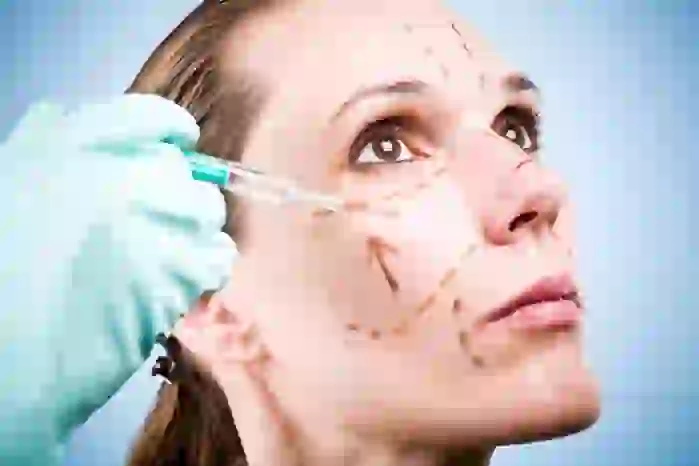
In the article we discuss what facial bioreinforcement is. We talk about performing the procedure using hyaluronic acid and liquid threads (fillers), what are the indications and contraindications for it. You will find out at what age bioreinforcement is done, when the results are visible, reviews from cosmetologists and women, and the cost of the procedure.
Bio-reinforcement of the face - what is it?
Bio-reinforcement of the face (vector lifting) is an anti-aging cosmetic procedure, the effect of which is aimed at combating deep wrinkles and pronounced signs of aging. The procedure helps strengthen facial tissues, making age-related changes less visible, and the patient herself looks much younger.
The first attempt to introduce facial reinforcement in the 90s was Hollywood gold threads. Currently, only a small part of plastic surgeons use them, since most specialists prefer modern materials.
Bio-reinforcement of the face is carried out using preparations based on hyaluronic acid, fillers, liquid threads (mesothreads) or cannulas. Vector lifting is recommended for patients with the first pronounced symptoms of gravitational aging, in the fight against which peelings or biorevitalization are powerless.
Video: Vector bioreinforcement of the face
What result should I expect?
It is necessary to perform the rejuvenation procedure only in trusted cosmetology clinics and with a good specialist. Before visiting a beauty salon, you can read reviews about it on the Internet or ask your friends and acquaintances who have already gone through this procedure.
Bioreinforcement of the face can only be performed if there are no contraindications. And so that the result does not disappoint you, you need to carefully follow all the recommendations for skin care after beauty injections. If you minimize any provoking factors in the first weeks after the puncture, healing will proceed faster.
When is the result visible? Usually, immediately after the procedure, it becomes noticeable how deep wrinkles are smoothed out and facial contours become smoother. The duration of the effect depends on the material used and the individual approach; in some cases, before bioreinforcement, it is advisable to undergo a course of facial biorevitalization.
Indications
With age, a person's skin begins to lose elasticity, causing it to sag and become wrinkled. These changes occur gradually - first the oval of the face floats, after which the eyelids droop.
As a rule, the use of simple and expensive cosmetics does not give any results. In this case, injections of special preparations that contain hyaluronic and polylactic acid come to the rescue. These active substances are produced by the cells of the human body and actively participate in the processes of blood microcirculation. The introduction of drugs with these components helps restore normal metabolic processes in the layers of the skin, which are characteristic of young age.
The procedure is recommended for women over 30 or 40 years old who have pronounced age-related changes, very dry skin and a swollen oval face.
Other indications include:
- the first signs of skin aging;
- desire to highlight cheekbones and correct lip contour;
- double chin;
- heavy eyelids;
- the need to adjust the shape of the face - as a rule, this occurs in women over 40 years old;
- voluminous cheeks (more details in the article How to remove cheeks) or tighten them;
- deep wrinkles on the forehead or in the nasolabial triangle;
- loose skin on the neck or rings of Venus in this area.
This type of contouring can be used to correct problem areas of the body. In this case, the puncture scheme is selected individually by a specialist.
How often should the procedure be performed? As a rule, the course consists of 3-5 sessions, between which there is a break of 2 weeks. The effect of these procedures lasts for several years, after which the procedure must be repeated.
List of drugs
When performing vector face lifting, the following types of drugs are used:
- Aptos threads are used quite rarely and only for mature skin due to the risk of tissue injury. Can eliminate deep folds on the skin.
- The complex, which contains polylactic acid, is a substance that affects the deep layers of the dermis and stimulates the formation of collagen. Recommended for use in women over 40 years of age.
- Fillers with hyaluronic acid - the active component acts superficially, activating the natural processes of skin renewal.
Training video
Execution technique
Vector face lifting includes the following stages:
- Preparation - before conducting a cosmetology session, you must consult with a dermatologist, cosmetologist and anesthesiologist (if there will be general anesthesia). You also need to undergo general tests to identify hidden diseases for which facial reinforcement is prohibited.
- Diagnostics - the drug for the procedure is selected based on the condition of the skin and after examining problem areas. Before injections, a test for an allergic reaction is mandatory.
- Anesthesia - before injections, local anesthesia is performed with an anesthetic cream. If the drug contains novocaine or lidocaine, then this step is skipped.
- Injections - after preliminary marking, the cosmetologist begins to inject the composition under the skin according to a certain pattern. The face seems to be stitched with liquid microthreads.
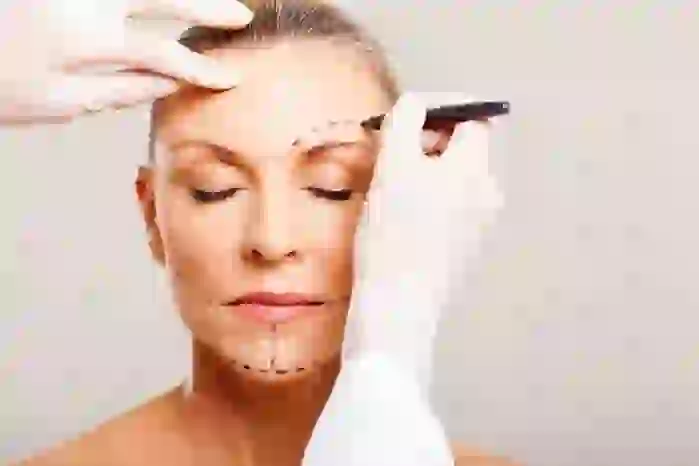
The technique for performing facial reinforcement should be chosen based on the characteristics of the skin.
Types of bioreinforcement
Before you begin the anti-aging procedure, it is advisable to familiarize yourself with its varieties and choose the one that best suits your needs.
Hyaluronic acid fillers
Vector face lifting with hyaluronic acid is a modern alternative to threads. Typically, dense gels (fillers) such as Juvederm ULTRA (2 or 3) and Surgiderm (18 - discontinued, 24) are used.
Injections are performed using a flexible cannula, the length of which is much longer than that of a regular needle. Thanks to this, pain is reduced and the active substance is evenly distributed in tissue cells. Injections are carried out in such a way that a dense mesh of the active component is formed, as a result of the installation of threads.
After introducing hyaluronic acid into the cells of the skin, it begins to dissolve, the degree of hydration of the cells increases, and the formation of elastin fibers begins. Thanks to this, the skin becomes denser and its elasticity increases.
Advantages of injection reinforcement:
- pain during the procedure is tolerable;
- the effect lasts up to 2 years;
- gradual resorption of hyaluronic acid;
- there are no foreign bodies in the tissues.
The disadvantage of the procedure is the possible need for a whole course of procedures, while the final result may be weaker than desired.
Video on the topic “Bio-reinforcement of the face with hyaluronic acid”:
The essence of this technique is that strengthening with threads occurs due to the body’s ability to instantly isolate foreign objects that penetrate the subcutaneous area using a connective tissue barrier. 1-1.5 weeks after the installation of liquid mesothreads, a collagen-elastin capsule begins to form around them, the action of which is aimed at maintaining the skin in the desired condition.
Types of threads used in facial bioreinforcement:
- absorbable - they are made from polylactic acid or caprolac;
- non-absorbable - thin platinum, gold, polypropylene or Teflon wires;
- combined options - a polypropylene wire with cones made of absorbable material is inserted into the base of the face.
The main advantage of this procedure is the pronounced, instant result. In this case, it is possible to regulate the tension of the tissues. The disadvantage of this rejuvenation method is the need to remove non-absorbable threads in the future if you want to undergo plastic surgery. In addition, thread lifting is ineffective when there is a large amount of soft tissue.
The procedure is performed under general or local anesthesia and lasts 45 minutes. The resulting effect lasts for a period of 1 to 5 years.
Video: Bioreinforcement of the lower third of the face
Skin care after the procedure
Depending on how properly you care for your skin after the procedure, the final result and the duration of healing of the skin largely depend. The main complications after beauty injections, as with any injection procedure, are the appearance of scars, swelling, bruises and pain.
To minimize side effects it is recommended:
- refrain from performing the procedure during or before menstruation;
- for frequent herpetic rashes, take antiviral medications;
- three days before the cosmetology session, start drinking “Ditsinon”;
- for 2 weeks before the procedure, it is forbidden to take painkillers and anticoagulants;
- When using general anesthesia during the procedure, it is mandatory to first consult with an anesthesiologist.
Since the preparations and threads used for facial reinforcement are made of high-quality biocompatible materials, the occurrence of allergic reactions is impossible.
Photos before and after
What effect should you expect from the procedure? It all depends on what drug is used to carry out the procedure. When using mesothreads, the result is visible immediately, while hyaluronic acid has a cumulative effect.
We invite you to look at the photos before and after bioreinforcement of the face using hyaluronic acid and threads.

Photos before and after the procedure 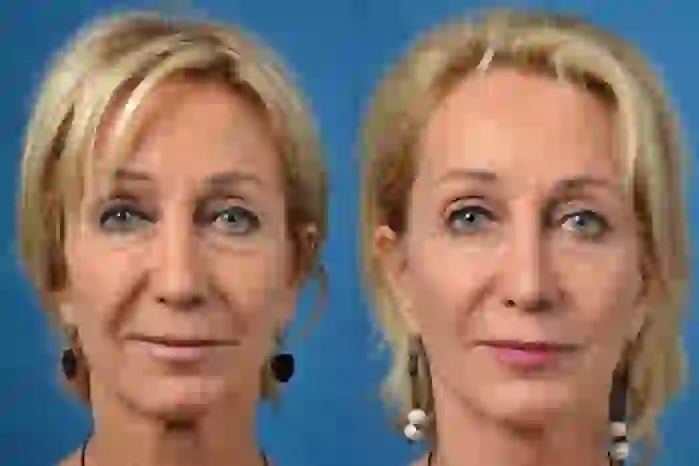
The result of using bioreinforcement with hyaluronic acid 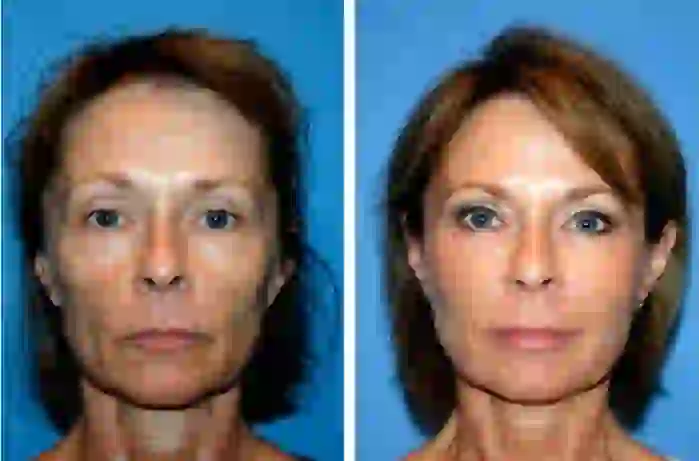
Effect before and after using facial reinforcement with fillers
Consequences
What will the face look like immediately after reinforcement? It almost always causes bruising and swelling. Sometimes hematomas are large, which is due to the individual characteristics of the body and the condition of the epidermis.
To prevent complications, after the procedure, refrain from:
- from hot baths, baths, saunas and swimming pools;
- from performing massage in the treated areas;
- from active sports and physical activity.
It is also recommended to grimace less and not treat your face with scrubs and peels until the skin has completely healed.
Contraindications
Bioreinforcement of the face, like any cosmetic procedure, has a number of contraindications for its implementation, including:
- pregnancy;
- taking antibiotics;
- blood clotting disorder;
- pustules on the dermis;
- autoimmune diseases;
- breast-feeding;
- predisposition to the development of keloid scars;
- thick facial skin;
- chronic diseases of the dermis in acute form;
- inflammatory processes in the epidermis.
An important rule: before undergoing an anti-aging procedure, it is recommended to take a comprehensive blood test to diagnose your general health. This is due to the fact that in some pathologies such a procedure is unsafe. It is also advisable to consult a dermatologist.
What are the pros and cons of the facial bioreinforcement procedure? The main advantage is obtaining the desired result, which means eliminating deep wrinkles and smoothing the skin. At the same time, the big disadvantage of the procedure is the high cost, especially considering that sometimes it is necessary to complete a whole course for the result to be noticeable.
The cost of the procedure depends on the reputation of the clinic and the professionalism of the cosmetologist. We suggest that you familiarize yourself with the average prices for bioreinforcement of the face in Moscow and St. Petersburg:
- non-injection reinforcement with surface compounds - 7-8 thousand rubles;
- filler Restylane (Restylane) - about 17,000 rubles per 1 ml;
- Ellanse - 32,000 rubles;
- Surgiderm complex (Surgiderm) - 14,500 rubles per 1 ml;
- mesothreads (from 30 pieces) - 35,000 rubles;
- drug Sculptra (Sculpture) - 25,000 rubles per 1 ml.
The cost of the procedure in the regions is slightly lower, approximately 2000-5000 rubles.
Reviews
We invite you to read the reviews of cosmetologists and women who decided to undergo bioreinforcement of the face.
Reinforcement of the face with hyaluronic acid or fillers is recommended for women over 40 years of age. These procedures contribute to noticeable rejuvenation for 10-20 years, while the effect of them lasts for a long time. But before agreeing to beauty injections, you need to consult a dermatologist and undergo general tests.
Vector face lift is a simple and effective anti-aging procedure that is suitable for most women. Yes, during it you can feel a slight but tolerable pain. At the same time, the rehabilitation period after injections is on average 1-2 weeks.
Inga, 49 years old, housewife
Several years ago I had my face reinforced with liquid fillers. The result surpassed itself. Firstly, all the deep wrinkles disappeared. Secondly, the skin itself has become more pleasant to the touch.
Samira, 52 years old, lawyer
Last year I did a vector face lift with hyaluronic acid. I didn't like the result at all. I had to perform 5 procedures to make the wrinkles disappear.
Veronica, 41 years old, entrepreneur
A couple of months ago I had a thread lift under general anesthesia. After waking up from it, I was delighted with the transformation, since visually I had lost 10 years.
Vladislava, 45 years old, manager
I saved for two years to get facial reinforcement. After the procedure, I immediately developed large hematomas on my face, which disappeared within 5 days. To be honest, a week after the cosmetology session, the reflection in the mirror did not make me happy. And only after 2 weeks I saw the effect of the procedure, deep wrinkles disappeared, and the skin itself became more elastic.
Facial bioreinforcement is an effective rejuvenation procedure that is expensive. It is for this reason that many abandon it in favor of home remedies for rejuvenation. At the same time, if you want excellent and long-lasting results, then only injections of hyaluronic acid and the use of mesothreads will help you regain your former beauty.
Video: Bioreinforcement of the face with cannulas
We are talking with a dermatocosmetologist, surgeon, candidate of medical sciences, certified trainer in injection techniques of the Nike-Med company, founder of the independent training center "IntoMedi" Natalia Shkolyar and cosmetologist, scientific consultant of the portal 1nep.ru Ekaterina Glagoleva.
Advertising happily assures us: both mesothreads and fillers successfully fight wrinkles, strengthen the skin framework, and provide a lifting effect (it is the last promise that attracts consumers the most). However, according to Natalya Shkolyar, it is completely wrong to identify their actions.
- The action of fillers is aimed at increasing volume: with their help, you can restore the youthful roundness of the cheeks and cheekbones, and even out the oval of the face. And fill the defects of the dermis - wrinkles and folds.
- With the help of mesothreads lying freely in the skin, a kind of bioreinforcement occurs. A needle with an attached thread is passed through the subcutaneous layer along certain vectors, after which it is removed, but the thread remains, and when absorbed, a collagen “framework” is formed around it.
There is a real confrontation between fillers and threads. In the heat of competition, they are ascribed advantages that are far from reality. Both methods are surrounded by many myths. In such a situation, it is very difficult for the consumer to make the right choice!
MYTH 1: The introduction of mesothreads and fillers rejuvenates the skin.

According to Natalia Shkolyar, this is one of the most dangerous misconceptions that most aesthetic medicine specialists are trying to introduce into our consciousness. Alas, no biological rejuvenation of the skin occurs. From the point of view of medicine in general and surgery in particular, the desired lifting effect is based on trauma to the soft tissues of the face, without visible marks on the skin. And recovery follows the principle of wound healing. When threads and fillers are introduced, the skin is damaged, soft elastic “micro-scars” appear inside, which contribute to a change in its optical density. As a result, the patient sees in the mirror that he begins to look younger.
Nowadays, all forced “rejuvenating” manipulations are increasingly presented as improving a person’s health. This does not add respect to people who mislead patients.

Ekaterina Glagoleva:
“As such, true skin rejuvenation does not occur when implanting threads made of smooth suture material. As soon as the technique appeared, many manufacturers assured that a thread of smooth suture material was placed in the middle layers of the skin and, due to the constant irritating effect, collagen synthesis processes were started. At the moment, the term “subdermal introduction of mesothreads” is increasingly heard, namely they are located in the hypodermis (subcutaneous fatty tissue), and we are no longer talking about synthetic processes of the dermal matrix.
Fillers based on hyaluronic acid have recently followed the path of evolution and combine stabilized acid to recreate volumes and unstabilized hyaluronic acid, which acts as a biorevitalizant. In this case, I rather began to talk about skin rejuvenation.”
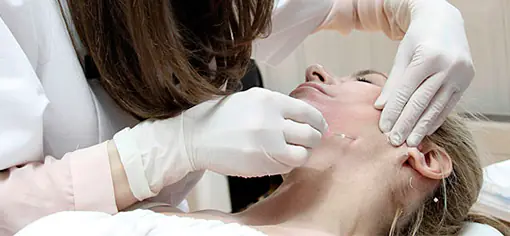
MYTH 2: Compared to fillers, mesothreads provide a greater skin tightening effect.
Natalya Shkolyar's opinion:
“To some extent this is true. When fillers are injected, the skin is smoothed by filling the volume lost with age, which at the same time contributes to its “tension”. With biorevitalization (point injection of gel), the skin also slightly lifts. Smooth absorbable mesothreads reinforce the fabric. Introduced into the skin, they create a kind of mesh in it, around which, when absorbed, collagen and elastin fibers, which have become chaotic and stretched with age, “twist”. They reduce their length, and the patient feels the skin tightens and becomes more elastic. However, this lifting effect is not very great by and large. The skin only “sits” slightly. Mesothreads have no effect on subcutaneous structures—fatty tissue and muscles that have shifted downward (the main cause of age-related ptosis). For these purposes, non-absorbable and absorbable deep insertion sutures (smooth or notched) are used, which are attached to bone structures.”
Ekaterina Glagoleva:
“The skin tightening effect is provided by threads that can be classified as lifting and reinforcing - these are notched threads that are fixed in the tissue and provide true lifting.
Smooth threads provide an indirect lifting effect by creating a frame in the subcutaneous fat and tightening the tissue at the injection sites.”
MYTH 3: The introduction of fillers based on stabilized hyaluronic acid gives the best aesthetic effect, since it is a natural component of the skin.
Natalya Shkolyar:
“That's not entirely true. Absorbable mesothreads mainly consist of polyglycolic and polylactic acids, while all over the world today it is believed that it is better to introduce polylactic acid, since, unlike hyaluronic acid, it also triggers the process of elastin synthesis. Collagen is always present in our skin. Its production is triggered by any injury. But to give the skin an even color, it also needs elastin. A very important point is that these should be poly-, and not monoglycolic and monolactic acids, in a concentration of about 75-85%. Only these parameters will ensure uniform disappearance of threads from the fabric.”
Ekaterina Glagoleva:
“The aesthetic effect is largely determined by the indications, contraindications and the main tasks facing the patient and the doctor. HA fillers or smooth threads? The choice should be determined by the anatomical zone, the severity of subcutaneous fat and, again, the main goals. In my opinion, the advantage of HA-based fillers is the presence of an “antidote” - hyaluronidase, which allows you to correct possible imperfections in the injection and is preferable for correction in young patients, and for the correction of potentially dangerous areas, taking into account the anatomy and choosing the correct dosages.”
MYTH 4: In terms of specific gravity, mesothreads are lighter than fillers. Therefore, they do not aggravate age-related ptosis.
However, to a greater extent, according to Natalia Shkolyar, this is not due to the “sagging” of soft tissues under the weight of the gel, but due to the fact that the injected volume is very difficult to control. If the filler is administered by a not very experienced specialist, overcorrection occurs, followed by a not very good aesthetic effect. It can be compared to using cling film. When you stop pulling it, it “shrinks up”. The same thing - alas! - happens to the skin: the so-called optical density of the tissue does not change for the better.
Ekaterina Glagoleva:
“Yes, we always take gravity into account and must remember that when we add weight to already heavy, sometimes swollen tissues, we aggravate the manifestations of gravitational ptosis. And the property of hyaluronic acid to retain moisture also plays a role in making tissue heavier. But injecting a large number of PDO-based threads (smooth threads) can also weigh down the tissue. Everything again comes down to a rational choice of methodology and quantity.”
MYTH 5: Unlike hyaluronic acid fillers, mesothreads do not cause swelling. Therefore, they can serve as an alternative for people prone to swelling.
Natalya Shkolyar:
“This is an absolute lie! Yes, hyaluronic acid attracts moisture, and due to this, it is considered one of the best skin moisturizers. However, high-quality (!) fillers based on stabilized hyaluronic acid produced by biotechnological methods do not cause swelling. Post-traumatic swelling, as a natural reaction of the skin to injury, develops after both procedures. The problem is that our market still uses a large number of gels based on hyaluronic acid of animal origin, poorly purified. That’s why many cosmetologists and patients note that there is a lot of swelling after fillers, but not after threads.”
Ekaterina Glagoleva:
“Mesothreads cause post-traumatic swelling, which can last for quite a long time. I won’t undertake to talk about the ability of a suture material based on polydioxanone yet; all experiments and research in this area relating specifically to smooth threads, and not to the suture material that has been known for a long time, are in the process of research.”
MYTH 6: Denser threads, unlike elastic gels, are much more likely to cause fibrosis - visible thickening of the skin.
According to Natalia Shkolyar, obvious fibrosis can occur in both cases. To say that after mesothreads it is more pronounced is incorrect. In some patients, as the threads are inserted, white, depigmented, very thin stripes appear on the skin. But a similar reaction, in the form of separate areas of the skin, sometimes develops at the injection sites of the filler. These side effects are most often associated with a violation of the technique - threads or fillers are “placed” too close to the surface of the skin, or the volume of injected filler is exceeded. Or chronic diseases acquired with age - young people do not come for such procedures. Less often - with the individual reaction of the body (genetic tendency to hypertrophic scars): as you know, everyone’s wounds heal differently. Unfortunately, these complications are almost impossible to correct using cosmetic and hardware techniques.
Ekaterina Glagoleva:
“Fibrosis is not so much visible skin thickening, but palpable and visualized according to skin ultrasound. The issue of tissue fibrosis is an open question in cosmetology. In response to any controlled injury, connective tissue is formed, which has its own timing and stages. This is the reason for heated discussions and discussions. When introducing HA-based fillers, the effect of injury is largely neutralized by the creation of a “healthy” microenvironment, because, as we read above, hyaluronic acid is a material closely related to human tissue.”
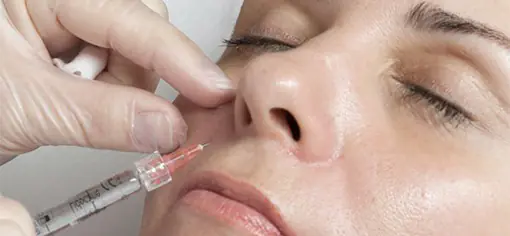
MYTH 7: Forehead reinforcement using mesothreads can serve as an alternative to botulinum toxin injections.
According to Natalia Shkolyar, the “Botox effect” after the introduction of mesothreads is a big exaggeration. It simply doesn't exist! Although this promise looks very tempting for people who are afraid of Botox or have contraindications to botulinum toxin injections. Botulinum toxin, affecting the passage of nerve impulses, disrupts muscle contraction. Mesothreads laid at a certain depth (the skin of the forehead is very thin, from 1 to 2 mm) create scar formations in the muscle tissue, as a result of which the movement of muscle fibers is disrupted. Due to this, the muscle contracts less. But, since the chemicals released during the resorption of the threads do not in any way affect the nerve endings, facial expressions still remain quite active. And there are facial expressions - there are also wrinkles!
Ekaterina Glagoleva:
“In my opinion, no: forehead reinforcement with mesothreads is not an alternative to botulinum toxin injections.”
Myth-making, as a result of competition between techniques, is a fairly common phenomenon. In order not to become his hostage, firstly, it is very important not to forget that each technique has its own indications and contraindications. Secondly, these techniques can be well combined. “If we talk about correcting aesthetic skin imperfections,” says Natalya Shkolyar, - today I would choose a combination of these techniques. Unlike fillers, threads by themselves cannot create volume. Moreover, if, for example, we are talking about creating volume in the cheek or cheekbone area, you can first reinforce the tissue using threads, and then, to create volume, introduce filler based on the same hyaluronic acid into this “reinforced” area. With proper reinforcement of the nasolabial fold, which cosmetologists are accustomed to filling with fillers, the first stage of reinforcement will significantly reduce the amount of injected gel. This will not only provide a better aesthetic effect, but will also make the procedure safer, minimizing the possibility of overcorrection.”
Advantages of the methods
Are common:
- correction of age-related skin changes with mesothreads and fillers is atraumatic for the patient (compared to operations);
- During the procedure, no incisions are made on the skin, the pinpoint points where the needles enter heal quickly, leaving no marks;
- there is no (or short) rehabilitation period;
- minimum (compared to operations) time for a procedure, 1 procedure = 45 minutes;
- mesothreads and fillers are ≈90% biocompatible with tissues.
Fillers:
- allow you to create the missing volume;
- fill (even out) even very deep wrinkles and folds;
- promote skin hydration (biorevitalization technology with fillers based on hyaluronic acid).
Mesothreads:
- the tissue reaction to the threads is insignificant, microcirculation disruption is minimized (fillers with overcorrection can cause necrosis - a severe disruption of microcirculation);
- longer lasting aesthetic result.
Indications
Almost the same for fillers and mesothreads:
- nasolabial folds, labiomental wrinkles;
- vertical and horizontal wrinkles;
- nasolacrimal groove;
- “purse-string” wrinkles around the lips;
- folds in front and behind the auricle;
- gravitational ptosis of the cheeks;
- eyebrow ptosis;
- folds of skin on the chin, neck, chest;
- sagging tissue on the buttocks, abdomen, arms, legs. (Due to the fairly high price, fillers are usually used in the face and décolleté areas; using threads on the body is cheaper).
- uneven relief of the skin and subcutaneous tissues after liposuction. (Both threads and fillers can be used, but the result from threads is brighter).
Contraindications
Almost the same for fillers and threads:
- autoimmune diseases;
- severe somatic diseases;
- blood diseases;
- collagenoses;
- coronary heart disease (relative contraindication);
- hemophilia (absolute contraindication);
- mental and neurotic disorders;
- various acute infectious diseases (ARVI, influenza, etc.);
- inflammation of the skin in the area of possible injection.
Bio-reinforcement of the face is a procedure in cosmetology and surgery aimed at rejuvenating the skin, tightening the oval, and shaping the desired facial contour. It is carried out using substances that affect skin cells, causing them to actively renew and grow.
Description of the procedure
Bio-reinforcement of the face is a modern cosmetic procedure carried out using various methods: hyaluronic acid, threads, fillers, preparations with substances beneficial to the skin (among the most famous: Radiesse, Aptos).
Using a very thin needle, a drug or threads are injected into the structural layer of the skin, forming a diamond-shaped lattice., with the help of which they tighten the necessary parts of the skin and smooth out the necessary areas on the face.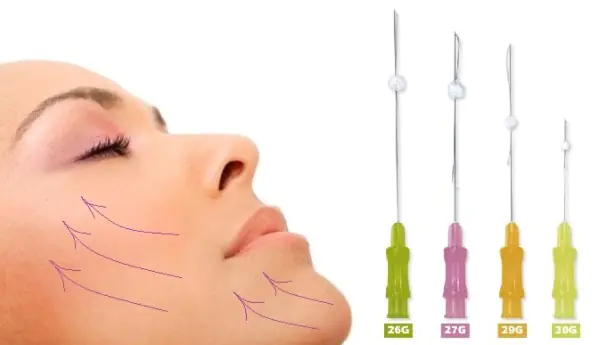
Having figured out what it is and how it affects the rejuvenation of appearance, you can choose the appropriate method with minimal possible side effects, consequences and great effectiveness.
The cosmetologist offers a type of bioreinforcement depending on the individual characteristics of the skin, face type, and patient’s health. This way, the necessary effects of tightening, taking shape, getting rid of wrinkles and deep folds are achieved.
Who is the procedure indicated for?
Cosmetologists recommend using the procedure no earlier than 35 years of age. This framework is due to the fact that younger girls produce collagen naturally and do not require additional stimulation. If you carry out a rejuvenation procedure, this can cause complications and harm the skin.
However, the aging process can begin much earlier, so first of all it is necessary to pay attention to external signs:
- loss of elasticity, sagging skin;
- changing the shape of the face;
- the appearance of wrinkles.
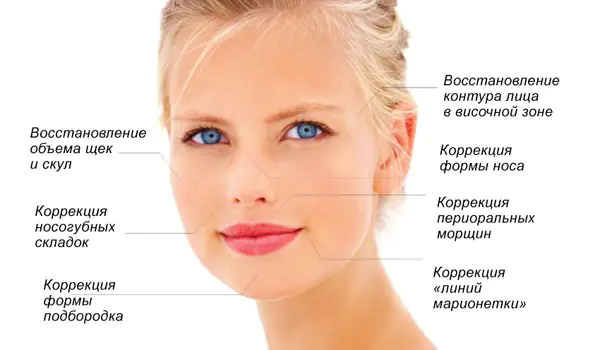
Bioreinforcement can be done not only on the face, but also in the neck, décolleté, arms, and other parts of the body at the request of the patient.
Only a cosmetologist can tell you exactly about the need for the procedure, the presence of indications and contraindications during a preliminary examination. A qualified specialist will also take tests, primarily on the body’s reaction to the drug, to see if it will cause allergies.
Operating principle
Polylactic and hyaluronic acids are produced directly by the body, but with age, their production slows down and cell renewal deteriorates. Introducing them into the body from the outside improves intracellular metabolic processes.
They directly affect skin cells, activating their renewal and collagen production. Hyaluronic acid, which is part of the injected drug, is absorbed and excreted from the body, so the rejuvenating effect is maintained for 6 to 12 months, after which it is necessary to repeat the procedure.
Bioreinforcement technique
The bioreinforcement procedure requires a serious approach:
- It is necessary to contact a professional clinic with high quality service. There, qualified personnel with medical education will immediately take a series of tests necessary to identify indications and contraindications for the procedure;
- The doctor determines places on the face or other parts of the body that require tightening and rejuvenation. In these areas, markings are applied in the form of a grid along which injections will be made;
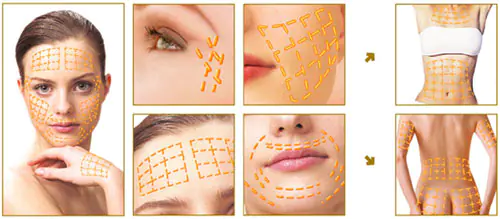
- After this, the skin is cleansed of impurities and cosmetics with a special solution;
- Before the procedure, an anesthetic is applied, most often creams with lidocaine are used, but in the case of thread reinforcement, or if the patient is afraid of pain, local or even general anesthesia may be used;
- The bioreinforcement procedure is carried out using syringes with a thin needle, which allows minimal trauma to the skin. The injected drug forms a network of threads under the skin that maintain the shape of the face and influence cells, causing them to actively produce collagen;
- The end of the procedure is treating the puncture sites with an antiseptic and sealing with a band-aid.
The subsequent condition of the skin depends primarily on the patient herself, since it must be properly cared for, especially careful in the first week after the procedure.
What biomaterials are used
When bioreinforcement of the face, in order to achieve exactly the result that the patient desires, two types of materials are used: biogel and biothreads, which, in turn, can consist of several types of substances:
- Biogel based on hyaluronic acid – naturally affects skin cells, does not cause allergies or rejection;
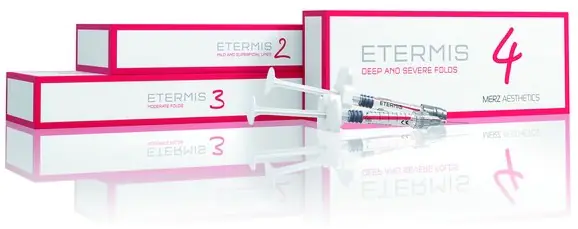
- Gel based on polylactic acid - lasts longer, has a more pronounced effect;
- Gel based on sodium hydroxyapatite – a substance made from sea corals using a synthetic method, since it is a component of bone tissue, and is used in cosmetology;
- Threads based on polycaprolactron - suture material used in medicine, after a certain period they dissolve. A significant advantage of this method is the ability of the threads to stimulate the production of neocollagenogenesis;
- Dioxanode-based mesothreads – biodegradable (dissolving) threads that do not cause rejection or allergic reactions.
Despite their name, biothreads are introduced under the skin not surgically, but with a syringe, like a gel, minimally damaging the tissue.
Using biothreads with polycaprolactone
Threads with polycaprolactron are introduced under the skin, like a gel, using a syringe, and are an equally popular means of lifting. However, they have a significant advantage over gel - the effect of using threads does not disappear for 3-5 years.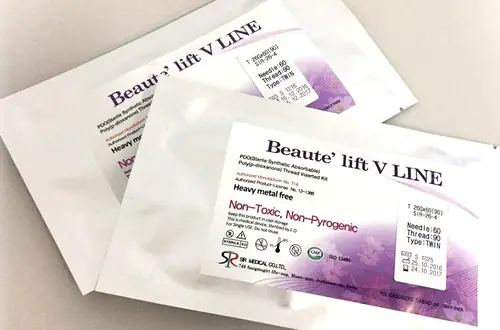
In addition, this method of rejuvenation has a number of advantages:
- compatibility with fabrics, which eliminates allergic reactions and rejection;
- natural dissolution of the thread after the period of action;
- stimulation of natural collagen production;
- no surgical intervention, resulting in a short recovery period.
Cosmetologists recommend resorting to this procedure between 35-50 years old, since it is not necessary before 35, and at a later age it is much more difficult to achieve the desired effect. Like any cosmetic or medical procedure, bioreinforcement has contraindications.
Application of fillers with hyaluronic acid
Hyaluronic acid gives a shorter-term effect, its effect is noticeable for about 6-12 months, but it manifests itself quite quickly. The pain of the procedure is minimal, and there is practically no recovery period. After skin treatment, no traces of injections remain.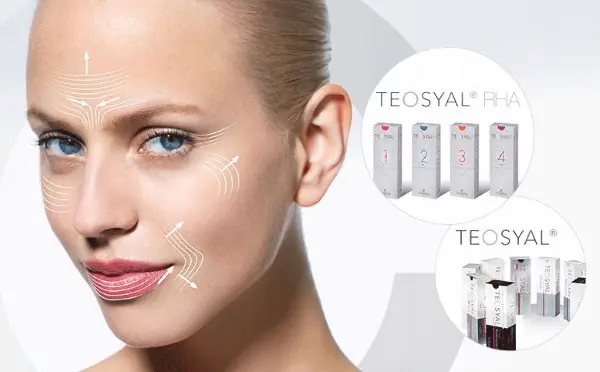
However, the procedure should be performed exclusively in clinics that have special certification. Otherwise, negative consequences may occur, such as pain, swelling and hematomas, inflammation, the formation of fibrous contracture, and vascular embolism.
Bioreinforcement with polylactic acid
Reinforcement with polylactic acid is a younger method relative to hyaluronic acid. It acts deeper and more actively, the effect lasts for about 2 years, but the procedure requires a course of injections, and not a one-time use.
Polylactic acid is produced synthetically and has a crystalline form.
When introduced under the skin, it interacts with connective tissue cells, which activate the synthesis of collagen fibers. After the effect of the drug ends, it breaks down into water and carbon dioxide and is excreted from the body.
How to prepare for bioreinforcement
For the bioreinforcement procedure, it is necessary to take into account many factors and carry out significant preparation.
Often, doctors’ recommendations relate to taking medications before the procedure:
- In order not to provoke increased pain, you should not do bioreinforcement during menstruation or within a week before it;
- The procedure can be carried out only a month after the end of the course of taking antibiotics, if any are taken;
- 2 weeks before the procedure, you should stop taking painkillers;
- 3 days before the procedure, it is recommended to stop smoking, drinking alcohol and eating junk food.
Stages of the procedure
Bioreinforcement occurs in several stages:
- Consultation with a dermatologist, examination of the skin for diseases, checking the reaction of the skin to the drug, identifying contraindications. After which a convenient date for the procedure is set;
- Cleansing the skin of cosmetics and impurities before the procedure;
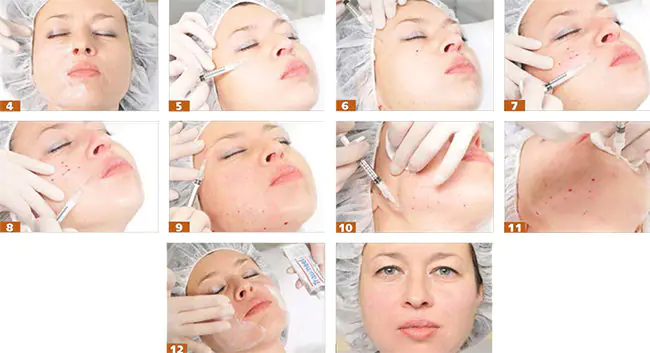
- Treatment of areas planned for injections with painkillers. This can be a special gel with lidocaine or a film when using fillers. As well as local, in some cases general, anesthesia for reinforcement with biothreads;
- If an anesthetic cream was used, it must be removed and the skin treated with an antiseptic;
- The last stage of preparation for the introduction of biomaterial is the application of special markings according to which biothreads will be created;
- At this point, the preparation is considered complete, followed by the direct introduction of the gel. For this purpose, special syringes with elongated needles are used - conuli. On average, one procedure takes 1-2 syringes;
- After completing the administration of the drug, the skin is treated with an antiseptic;
- The procedure lasts from 30 minutes to 2 hours. In cases with gels based on hyaluronic and polylactic acids, a course of procedures is carried out.
Facial skin care after
Often, after the procedure, swelling and abrasions occur within 5-7 days, after which they disappear, but to prevent contamination and inflammation, 2-3 days After the procedure, the skin must be treated with an antiseptic and a special cream appliedPrescribed by a doctor.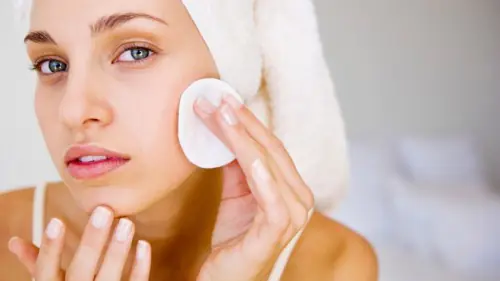
There is also a list of actions that should be avoided to avoid complications:
- long-term thermal effects, namely, do not stand at the stove for a long time, make compresses, steam the skin, or be in direct sunlight for a long time;
- visit the sauna, go to the bathhouse or pool;
- use cosmetics, both decorative and skincare;
- play sports and strongly strain your facial muscles.
Duration of the recovery period
When using biogel, the recovery period is quite short: within just 5-7 days, swelling and traces of injections will be noticeable, after which they disappear with proper care.
The use of biothreads requires a longer recovery period, namely 1-2 weeks.
Many doctors recommend taking the drug “Diction”, and also prescribe ointments and creams for faster removal of swelling and injection marks.
Duration of the effect of the procedure
Depending on the type of drug and its main substance, the period of effectiveness of the bioreinforcement procedure varies:
- The effect of the procedure of reinforcement with gel with hyaluronic acid is the fastest: it lasts 6-12 months. After the end of the period of action, the procedure must be repeated, or another type of rejuvenation must be chosen.
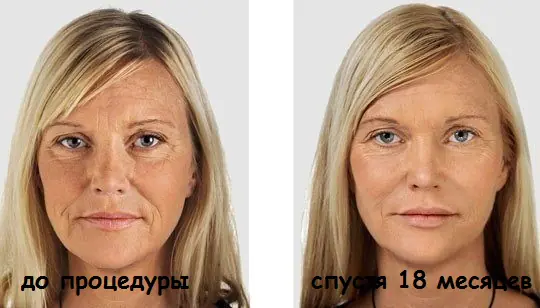
The effect of facial bioreinforcement lasts from 1 to 2 years.
Contraindications
When bioramming the face, so that these actions do not cause harm to the body, it is necessary to take into account contraindications.
You should refrain from the procedure in the following cases:
- during pregnancy, menstruation or breastfeeding;
- during exacerbation of chronic diseases;
- people with diabetes, epilepsy, and poor blood clotting;
- during inflammatory processes in the body;
- simultaneously with taking other drugs.
Side effects
Among the standard side effects from the bioreinforcement procedure are swelling, hematomas at the injection sites, bruises that disappear within a couple of days, Possible complications caused by incorrect procedure or poor quality of the drug:
- allergy;
- the appearance of granulomas;
- accumulation of gel under the skin;
- gel contouring;
- embolism;
- necrosis.
To avoid these consequences, proper skin care is necessary. If symptoms have already appeared, you should immediately consult a doctor.
Precautions during and after bioreinforcement
Bio-reinforcement of the face is a procedure that requires significant preparation and attention to skin care. The main rule is to carry it out only in a certified clinic by professionals., and otherwise complications may occur.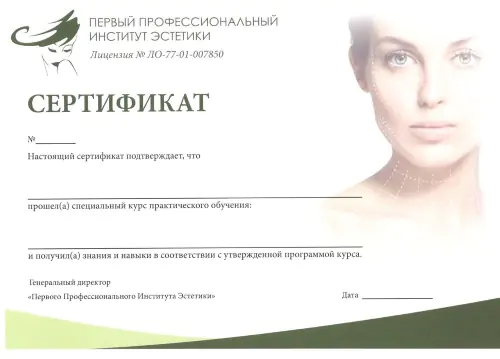
After the procedure, careful skin care is necessary, you need to avoid irritation and damage, use creams and ointments prescribed by your doctor.
If the procedure is carried out in the warm season, when the influence of the sun on the skin is increased, the doctor may prescribe special protective agents. If he does not do this, you should draw his attention to increased solar activity. This also applies to the cold season - frost can greatly harm the delicate facial skin.
Benefits and harms
Bioreinforcement has a number of advantages, thanks to which this procedure has become popular, namely:
- materials compatible with the human body;
- no surgical intervention;
- quick results;
- short recovery period;
- Possibility of use on other parts of the body.
Some disadvantages:
- not long-term effect;
- the need to conduct a course consisting of several procedures;
- possible occurrence of side effects and complications.
Permissible frequency of use
To determine the frequency of facial bioreinforcement, it is necessary to pay attention to such an aspect as the drug used. Reinforcement with hyaluronic acid-based gel is carried out in courses of 3-5 times, with an interval of about 2 weeks. After the course, the effect of the procedure is maintained for a year, then it needs to be repeated.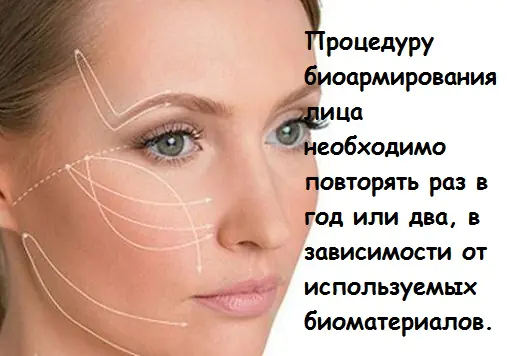
Polylactic acid is a more radical method; often one procedure is enough for a period of 1-2 years. The most long-term reinforcement is with biofilaments; they last for 5 years. These periods may vary depending on the condition of the skin and the body as a whole; only a doctor can clarify them during an examination before the procedure.
Price
The cost of the procedure depends not only on the type, but also on the drug used, the number of threads or fillers, which is selected individually, and the prestige of the clinic.
Price:
- Reinforcement with threads is the most expensive. Its cost is approximately 60-70 thousand rubles.
- The price of bio-reinforcement with gel varies from 13,000 to 35,000. A gel with hyaluronic acid will be much cheaper than one based on polylactic acid.
Recommendations from cosmetologists
When deciding on bioreinforcement of the face, several aspects should be taken into account:
- Age. For girls under 35, this procedure can even cause harm, this is due to the fact that the body produces natural collagen and stimulation of its production is not necessary;
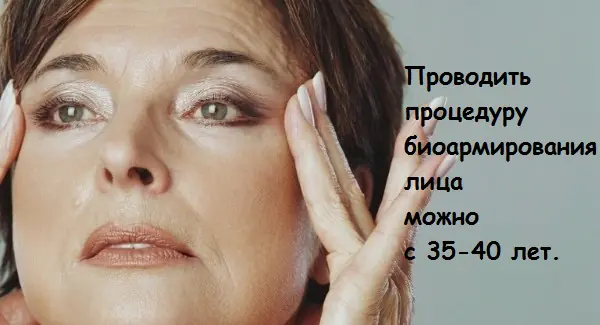
- Skin condition. Even for those over 35, the procedure may be completely unnecessary, since skin aging varies from person to person. First of all, you need to pay attention to the appearance, the presence of wrinkles and deformations of the face shape. In some cases, the aging process begins earlier than 35-40;
- Level of the clinic and professionalism of specialists. Carrying out the procedure at home or with a non-professional technician is strictly prohibited; this can result in many undesirable consequences and complications;
- The need to repeat the procedure. Depending on the type of bioreinforcement, it can be effective from one to five years. However, after that the procedure will still have to be repeated in order to maintain youth and beauty;
- Follow your doctor's recommendations. Many people believe that doctors’ warnings can be ignored, but this is not at all the case; after the procedure, the skin should never be injured, as this can result in significant complications.
What do doctors think?
Many doctors recommend bioreinforcement as a newer, safer and more technologically advanced method of rejuvenation.
The following aspects of the procedure are noted:
- Safety. Thanks to the latest technologies and high-quality drugs, the risk of complications is minimized;
- No surgical intervention. Unlike reinforcement with gold threads, this method of rejuvenation does not require surgery, it is rather a cosmetic procedure;
- Short recovery period. Due to the fact that this method is non-surgical, the recovery period after the procedure is reduced several times;
- Does not harm the body. The substances are not only not harmful, but are even beneficial for the patient, since they stimulate the natural processes of collagen production.
The facial bioreinforcement procedure is one of the latest developments in the field of cosmetology. The technique is effective, relatively safe, and allows you to maintain a youthful appearance for many years.
Video: how facial bioreinforcement is performed
Facial bioreinforcement technology in the video:
Find out what facial biomorphing is in the video:



